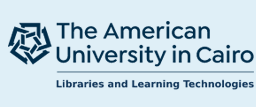-

External factors in the reorientation of Egypt’s economic policy
Galal Ahmad Amin
[no abstract provided]
-

On timely channel coding with hybrid ARQ
Ahmed Arafa, Karim Banawan, Karim G. Seddik, and H. Vincent Poor
[abstract not available]
-

The use of granite slurry in masonry manufacturing
Nada Attia, Omar Moustafa, Mohamed Abdeldayem, Rafik Yanni, and Basma Elsobky
[abstract not available]
-

Migration and Refugee ‘Crisis’ in the Euro-Mediterranean Region: Which ‘Crisis’? And for Whom?
Ibrahim Awad
This issue of Cairo Papers takes up the various dimensions of migration and refugees in the Euro-Mediterranean region over different periods in the last two centuries. It looks at both the migration of waves of Italians and Greeks to Egypt from the mid-nineteenth to the early twentieth century, and at migration from the Arab southern and eastern rims of the Mediterranean to Europe starting in the twenty-first century. The disciplines of history, sociology, anthropology, and political science have been mobilized to undertake the research its chapters embody. They address the history of migration in the region, relations between Mediterranean countries of origin and their diasporas, the impact of interest groups on the formulation of migration policies in countries of destination, and the policies for integration of recent flows arriving in Europe. The chapters are based on papers delivered at Cairo Papers 25th annual symposium in collaboration with the Center for Migration and Refugee Studies.
-

Interest Groups and Refugee Policy-Making: The Case of Germany
Maysa Ayoub
This issue of Cairo Papers takes up the various dimensions of migration and refugees in the Euro-Mediterranean region over different periods in the last two centuries. It looks at both the migration of waves of Italians and Greeks to Egypt from the mid-nineteenth to the early twentieth century, and at migration from the Arab southern and eastern rims of the Mediterranean to Europe starting in the twenty-first century. The disciplines of history, sociology, anthropology, and political science have been mobilized to undertake the research its chapters embody. They address the history of migration in the region, relations between Mediterranean countries of origin and their diasporas, the impact of interest groups on the formulation of migration policies in countries of destination, and the policies for integration of recent flows arriving in Europe. The chapters are based on papers delivered at Cairo Papers 25th annual symposium in collaboration with the Center for Migration and Refugee Studies.
-

The different faces of open in Egypt
Maha Bali and Nadine Aboulmagd
MOOC discourses originating from the Global North can appear potentially colonizing to educators in the Global South. Even though the initial hype around MOOCs has died down, there is still an overall belief in the liberating potential of open education which ignores the shortcomings of the practice on the ground. In this chapter, we contextualize open education from an Egyptian perspective and refer to different open educational practices we have been involved in, including the creation of Arabic content based on Western models (e.g., Edraak MOOCs, Wikipedia Arabic, and Tahrir Academy). Bali and Aboulmagd also discuss the creation of local OERs using local models, the reuse of existing English-language Global North content (e.g., MITx with AUC/AUB, translating edX content in Edraak, etc.), and participation in existing connectivist MOOCs as facilitators. These authors also describe an open project co-founded by one of the authors called “Virtually Connecting”. Importantly, this project challenges the marginalization of Global South scholars and others in education such as contingent academics, graduate students, and others. In doing so, they highlight how openness, when contextualized to different regions, can look different and have multiple faces.
-

Linguistic unrest at times of revolution: The case of Tunisia, Egypt, and Libya
Reem Bassiouney
© The Editor(s) (if applicable) and The Author(s) 2019. This chapter examines data from Egypt, Libya, Tunisia, and Sudan, which share one language, and witnessed more or less violent upheavals in the period since 2011. Linguistic forms and codes played a crucial role as a symbol of power and a tool to dominate. The chapter concentrates on media and public discourse, re-evaluating the relation between language and conflict. We argue that linguistic codes are resources for individual and also a point of contention during or after conflicts. In Egypt, Tunisia, and Libya, linguistic codes were contested, and the authentic identity of revolutionaries during the three revolutions was always questioned by the pro-regime group. The chapter analyses the use of linguistic codes, evaluating them in relation to linguistic theories including the concepts of indexicality, performance, and metalinguistic discourse.
-

Modern applications of the bateman-whittaker theory
Ioannis M. Besieris and Amr M. Shaarawi
[abstract not available]
-

Design of a two-tier WSN-based IoT surveillance system with cloud integration
I. Chukwuemeka Chimsom and Maki K. Habib
[abstract not available]
-

Kaleidoscopic Out-Migration: The Departure of Foreigners from Mid Twentieth Century Egypt
Angelos Dalachanis
This issue of Cairo Papers takes up the various dimensions of migration and refugees in the Euro-Mediterranean region over different periods in the last two centuries. It looks at both the migration of waves of Italians and Greeks to Egypt from the mid-nineteenth to the early twentieth century, and at migration from the Arab southern and eastern rims of the Mediterranean to Europe starting in the twenty-first century. The disciplines of history, sociology, anthropology, and political science have been mobilized to undertake the research its chapters embody. They address the history of migration in the region, relations between Mediterranean countries of origin and their diasporas, the impact of interest groups on the formulation of migration policies in countries of destination, and the policies for integration of recent flows arriving in Europe. The chapters are based on papers delivered at Cairo Papers 25th annual symposium in collaboration with the Center for Migration and Refugee Studies.
-

The effect of the moisture content on some mechanical properties for casuarina wood
M. Darwish, M. Hussein, and Khaled Nassar
[abstract not available]
-

Modeling of double-gate LDMOSFET devices including self-heating
Mohamed M. El-Dakroury, Mohamed I. Eladawy, Zaki B. Nosseir, Yehea Ismail, and Hamdy Abdelhamid
[abstract not available]
-

Offering engineering students global perspective through experiential learning project in wind energy and sustainability
Lamyaa El-Gabry and Martina Jaskolski
[abstract not available]
-

An LTE-based Multicast Scheduling Technique for Critical Smart Grid Communications
Mariam El-Hussien, Yasser Gadallah, and Hani Ragai
[abstract not available]
-

Optimized Production Control Policy for Hybrid MTS-MTO Glass Tube Manufacturing Using Simulation-Based Optimization
Ahmed Ellabban and Tamer Abdelmaguid
[abstract not available]
-

On the Reliability and Flexibility of FPGAs for Fault Tolerance in Sectored Networked Control Systems
Rana H. Elmaraashly, Gehad I. Alkady, Ramez M. Daoud, Hassan H. Halawa, Hassanein H. Amer, Ihab Adly, and Tarek K. Refaat
[abstract not available]
-

Optimizing Production and Inventory Decisions for Mixed Make-to-order/Make-to-stock Ready-made Garment Industry
A. M. Elmehanny, Tamer F. Abdelmaguid, and A. B. Eltawil
[abstract not available]
-

Noncoherent MIMO codes construction using autoencoders
Mohamed A. Elmossallamy, Zhu Han, Miao Pan, Riku Jantti, Karim G. Seddik, and Geoffrey Ye Li
[abstract not available]
-

System for detecting and reporting cell phone distracted drivers
Youssra Elqattan, Mohamed N. Moustafa, and Mohamed H. El-Shafey
[abstract not available]
-

Drone base station trajectory planning for optimal resource scheduling in LTE Sparse M2M networks
Zeinab El Sayed and Yasser Gadallah
[abstract not available]
-

A framework to measure e-participation level of government social media accounts
Mohamed Elsherif and Nahed Azab
© 2019 held by the owner/author(s). Publication rights licensed to Association for Computing Machinery. There is a rising attention to the importance of social media for e-participation due to its value in creating a convenient communication channel with citizens. Evaluating e-participation is eventually an important milestone for progress. The objective of this research is to provide guidelines for a framework that assesses e-participation on government's social accounts. Based on the work of Tambouris at el., 2007 [1] and Nelimarkka at el., 2014 [2], the research proposes a framework that could be applied to Facebook government accounts. This research though covers three major gaps in previous e-participation assessment research: scarcity in evaluating eparticipation within developing contexts, reliance on limited rather than large-scale empirical data, focusing on online government portals as an assessment e-participation platform and not considering social accounts' performance. This research is supported by Crowd Analyzer [3], a social media monitoring tool, to enable data crawling and users comments' sentiment analysis.
-

SWSP: Socially-Weighted Shortest Path Routing for Practical Internet of Things Applications
Mostafa El-Tager and Yasser Gadallah
[abstract not available]
-

Fault-Tolerant high-rate ethernet-based networked control system
Abdallah Gabara, Ramez M. Daoud, Hassanein H. Amer, Dina G. Mahmoud, and Hany Elsayed
[abstract not available]
Printing is not supported at the primary Gallery Thumbnail page. Please first navigate to a specific Image before printing.


